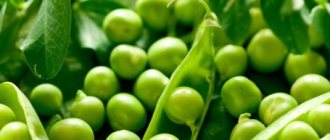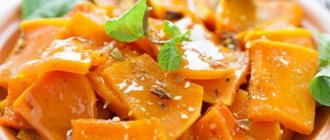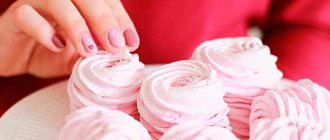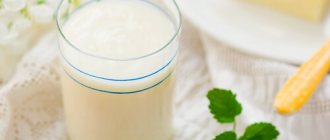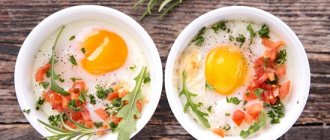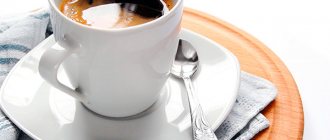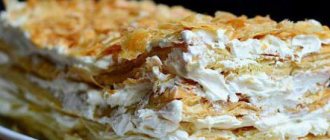How many calories are in tea without sugar?
There is always tea in the life of each of us, some drink it with sugar, some without it, some drink green, others prefer black. There is a lot of different information about different types of tea, but probably no one will give an exact answer how many calories it contains.
In black tea
Many people like to drink black tea in the morning; it helps to wake up, because it contains caffeine and many people know about it. 100 ml of this drink contains 4-5 calories, respectively, drinking a cup of tea in the morning your body receives about 10 calories. If you can’t imagine your life without tea, don’t worry and drink it as much as you like, it won’t affect your figure in any way.
In green tea
Some people prefer to drink green tea because it is considered healthier. The question of the nutritional value of this drink began to be raised by nutritionists, who noticed that their patients lost excess weight with the help of this drink. It is also important to know the calorie content of green tea when creating weight loss programs.
Leaf green tea without the addition of honey, fruit additives and, especially, sugar also has a minimum nutritional value - 1-4 calories. It is worth noting that these are not kilocalories, i.e. One cup of green tea contains only 0.005 kcal. Therefore, you can drink 3-4 cups of tea every day without harming your figure at all, and even, on the contrary, with its help you can lose a couple of extra pounds. Green tea is popular for its properties to improve metabolism.
In other types of tea
Today, more than 1,500 varieties of tea are produced around the world. The variety of this drink depends on the method of processing the collected leaves; in addition to the well-known black and green, there are also the following types:
- white tea - unfermented;
- red, yellow and purple - semi-fermented;
- herbal, fruity, floral (hibiscus), flavored - special varieties.
Each person chooses the type that brings him more pleasure and suits his taste preferences. The calorie content of tea, in principle, does not depend on the processing method, although there are differences between varieties:
- white - 3-4 calories;
- yellow - 2;
- hibiscus - 1-2;
- herbal (depending on composition) - 2-10;
- fruity - 2-10.
The nutritional value of these varieties is also not high if you consume this drink in its pure form, without additives. The resulting amount of calories is easily burned during daily physical activity.
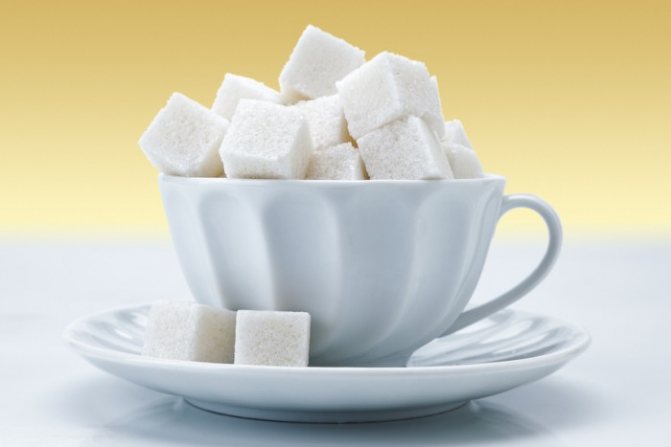
Calorie content of black and green tea
The answer to the question of how many calories are in tea depends primarily on the type of product. Black tea is a product during which the leaf went through a fermentation stage. The result is a product in which the original set of constituent components has been modified. Some substances pass into others, new compounds are formed or old ones evaporate.
How many calories are in black tea? The calorie content of the infusion is on average from 3 to 5 kcal per 100 ml. The more fermented the tea, the more calories it contains. If we consider dry tea leaves, then per 100 g there are about 140-160 kcal.
How many calories are in green tea without sugar? 100 ml of infusion can contain from 0 to 3 kcal. This weight is due to the fact that green tea does not go through the fermentation stage and new carbohydrates are not formed in it. The calorie content per 100 grams of dry tea leaves is about 100 kcal.
Thanks to such low weight, tea is included in every weight loss diet. It improves digestion, speeds up metabolism, and helps remove excess fluid due to its mild diuretic effect.
If you drink the drink before meals, it will help control your appetite and prevent you from eating too much. You can drink up to 6 cups of good loose leaf tea per day. Moreover, if it is green, then this particular dose contains enough antioxidants to prevent many diseases, including neoplasms.
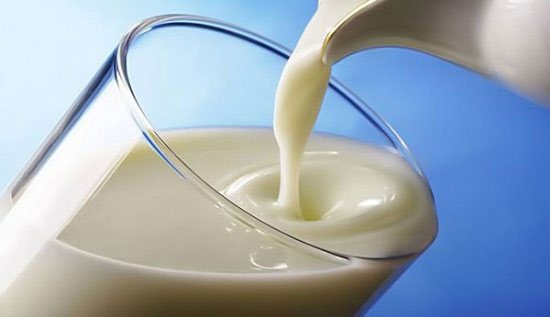
You can use skim milk, then the calorie content of the drink will not scare you
Calorie content of tea with sugar
Most often, people prefer to drink tea with sugar, in which case this drink turns from our friend into almost an enemy. Adding at least 1 tsp to a cup of tea. Adding sugar increases the calorie content of this drink not by 2 or even 3 times, but by 10 times.
Black tea with sugar
It is worth paying attention to the calorie content of tea for those who prefer to add a couple of spoons of sugar to it. So, 1 tsp. sugar = 30 kcal. Adding two teaspoons of sweetener to 200 ml of your favorite drink makes it high in calories - 70 kcal. Thus, daily consumption of 3 cups of black tea adds a little more than 200 kcal to the daily diet, which can be equated to a full meal. This is very important to consider for those who monitor their nutrition and adhere to a strict diet.
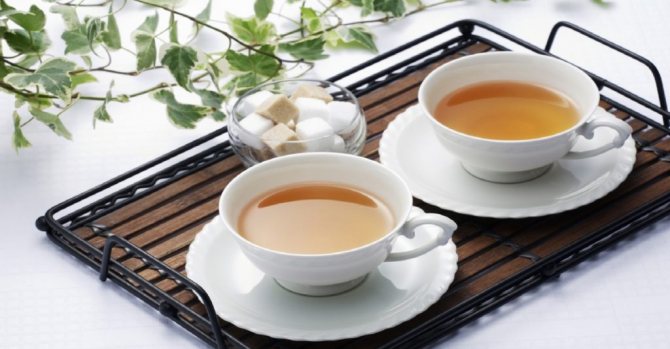
iinost-chaya-1-780×405.jpg 780w, https://chayguru.info/wp-content/uploads/2019/01/kaloriinost-chaya-1-1170×610.jpg 1170w" sizes="(max- width: 1024px) 100vw, 1024px" />
Green tea with sugar
Scientists confirm that this drink has great benefits for the body. In loose leaf tea without additives there are up to 4 calories, in some tables you can even find zero calories. But the nutritional value of this drink increases noticeably when sugar is added to it up to 30 kcal. In addition, it is noted that the addition of granulated sugar significantly reduces the taste of the drink.
Other types of tea with sugar
As has already become clear, tea itself has a low calorie content, but it increases significantly when you add at least 1 tsp to a cup of hot drink. Sahara. And there are sweet lovers who can add 3 or even 4 tsp to a cup of tea. Sahara.
So, what is the calorie content of a cup of tea with 1 tsp. Sahara?
- white tea - 45 kcal;
- yellow - 40;
- hibiscus - 36-39;
- herbal (depending on composition) - 39-55;
- fruity - 39-55.
What components make up the calorie content of tea?
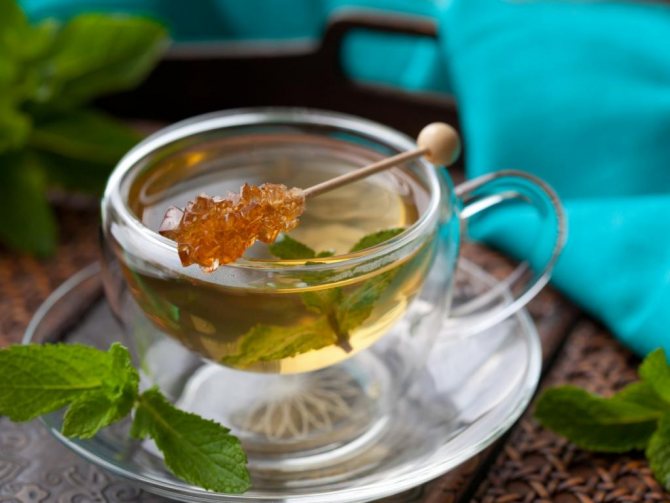
The commonness of tea as a drink makes a person perceive its nutritional value as something insignificant. However, many people drink this drink several times a day, generously flavoring it with all sorts of additives that improve the taste and add beneficial properties. That is why the issue of the nutritional value of tea, both separately and with additional components, needs to be considered.
The final calorie content of tea per 100 grams - both with and without sugar - is influenced by several factors in combination:
- Tea fermentation technique. It is known that black tea has the highest calorie content, while green, white and other types can be called dietary.
- The form of processing to which the tea has been subjected also has an effect on the energy value. The leaf has the highest calorie content. Then at least the nutritional value of tea bags.
- The number of additives used to prepare the drink. Per 100 grams of calorie content of tea with sugar and additives, 10-20% can come from parts of other plants, pieces of fruit, caramel and milk.
Thus, when calculating, you need to rely, first of all, on what kind of drink you are using.
On the topic: Recreational tourism - what is it? Types and development of recreational tourism
How many calories are in a cup of tea with additives?
The calorie content of tea can only be increased by the additives that each of us is accustomed to adding to it.

Milk
The tradition of drinking tea with milk came to us from England; today many people also add a little milk to their favorite drink. Despite the fact that such a drink is extremely healthy and easily digestible, its calorie content increases noticeably. So, 100 ml of milk, depending on the fat content, ranges from 35 to 70 kcal. A tablespoon of milk contains approximately 10 kcal. Using simple mathematical calculations, you can independently calculate the calorie content of the drink you consume.
With honey
Everyone knows that honey is a natural product that is incredibly beneficial for humans. But few people know how high in calories it is.
Important!
So, 100 g of honey can contain up to 1200 kcal, respectively, in a teaspoon up to 60 kcal. The energy value of this product depends on the ratio of glucose and fructose, and depending on the variety it can differ significantly.
Moreover, its benefits outweigh all the risks of gaining weight, because honey improves metabolic processes in the body.
With jam
Many people prefer to add jam or berry syrups to tea, but this addition is very high in calories, because it contains the maximum amount of sugar. Everything depends, of course, on the composition and consistency; the least amount of them is in cherry and rowan jam. On average 2 tsp. any jam up to 80 kcal.
Condensed milk
This milk powder product contains a lot of sugar and 100 ml of condensed milk contains 320 kcal. By adding such an additive to tea, you significantly reduce its benefits and add almost 50 kcal to your daily diet.
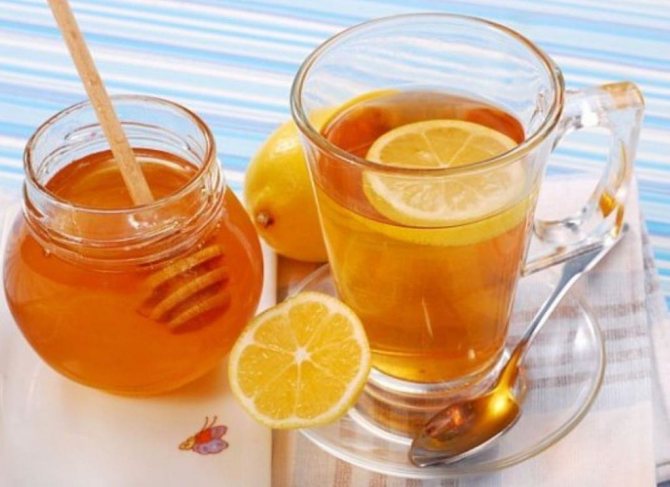
With lemon
This is an excellent addition to tea and will make it even more beneficial. 100 g of lemon contains only 30 kcal, and a small lemon slice contains no more than 2 kcal.
Sweeteners
Additives such as Jerusalem artichoke syrup and stevia contain fewer calories than sugar. But we categorically do not recommend adding chemical sugar substitutes (isomaltose, saccharin, etc.) to the drink, because they only disrupt metabolic processes and can provoke gastrointestinal diseases.
Tea is an excellent drink that will not only quench your thirst, but also improve the general condition of the body. But it can bring maximum benefit only in its pure form; all possible additives only increase its nutritional value.
Source: chayguru.info
Calories and additives
Important: all calculations are based on loose leaf tea, not tea bags. The difference is in its quality and variety. Loose leaf tea has the highest quality and value, especially if consumed with milk, softening the taste. Calorie content depends little on the variety; this indicator is so insignificant that it can be overlooked.
Another thing is usefulness and organic properties. You can find out how many calories are in green tea using this table.
A person who constantly monitors his weight always counts calories in all dishes and drinks. It is enough to simply calculate the energy value when it is indicated on the package. But it happens that this information is not given or the product comes without packaging. For example, quite often the calorie content of tea is not indicated.
But many people love to drink this drink. It invigorates the body well in the morning, and perfectly maintains strength throughout the day. But few people pay attention to how many calories are in tea.
Not all people can drink black teas without added sugar. It is worth considering that one spoon of sugar contains 30 calories. Let's try to calculate how many calories tea will contain when adding sweetener to it.
The average person puts two teaspoons of sugar per cup. It turns out that the calorie content of such a product will be 65 kcal. About 3-4 cups are drunk per day. In terms of calorie content, this can be compared to a full meal.
Currently, there are many different sweeteners. They give the drink a sweetish taste and practically do not increase the calorie content of tea. But according to nutritionists, these substances can cause significant harm to the entire body. At the same time, the stomach will receive sweet tea, and there will be a feeling of lack of sweets in the head. Therefore, it is better to drink teas with added sugar.
Calorie content of tea additives
What is the energy value of Hibiscus and Puerh tea drinks? Tea is a dietary product. It can be drunk by people of any age and health status.
Hibiscus
Hibiscus has a rich wine color. For brewing, hibiscus or Sudanese rose flowers are used. In the East, everyone drinks the drink without exception. Hibiscus has 5 brewing levels, which determines the color and beneficial properties of the product.
The drink has the ability to normalize blood pressure. To increase it and get a boost of energy, brew natural Hibiscus and drink hot. If you need to reduce the pressure, you should cool it and enjoy the sourness of the chilled drink. It has a diuretic effect, reduces the concentration of cholesterol in the blood, and has anti-inflammatory and antibacterial properties.
Hibiscus contains vitamins B, A, PP, C, potassium, calcium, beta-carotene, phosphorus. It should not be taken during pregnancy or planning. It has an estrogenic effect, stimulating uterine contractions and inhibiting the process of egg maturation. Excessive consumption leads to decreased concentration.
Pu'er is the national pride of China. Its history goes back 2 thousand years. Then, in the highland province of Yunnan, local residents began making a drink from the leaves of the tea tree (rather than the bush used for other varieties). For Pu'er, unripe leaves are collected and fermented first in a damp, foggy environment and then under the hot sun.
After fermentation, Pu-erh is aged. The process takes years, so the tea changes its taste. Fine drinks are prepared from raw materials collected 100 years ago. Pu-erh is sold in the form of loose tea leaves and pressed briquettes or balls.
Common additives are sweet raspberry jam, sugar, lemon. What are their caloric content and how many calories are in one cup of drink?
Sugar is a quickly digestible carbohydrate. It activates blood circulation in the spinal cord and brain, so complete refusal of the product is fraught with the onset of sclerotic changes in the body. However, you shouldn't get carried away with it. Weight of 1 tsp of sugar: 8 grams, energy value – 35 kcal.
Calorie content of tea with and without sugar
• In 200 ml of sweet tea with two spoons of sugar: 72 kcal. • In 300 ml of tea without sugar: 3 kcal.
Tea with honey strengthens the immune system, helps fight colds, and reduces cough. By brewing a bag and adding a level tablespoon of honey, you will increase the calorie content by 64 kcal. Energy value of the additive: 320-400 kilocalories per 100 g, depending on the variety. A heaping tablespoon contains 95-110 kcal, a teaspoon – 30-35 kcal.
Citrus fruits are healthy due to their high vitamin C content. Their nutritional value is low. Calorie content of 100 grams of lemon is 34 kilocalories. By adding 1 slice to tea, you will increase the energy value by 3-4 kcal. Citrus will give the drink a unique aroma and increase its benefits.
Milk
Milk tea is the British favorite drink. When using the supplement, the calorie content increases. 100 ml of milk contains 3.2% fat – 60 kcal. One teaspoon contains 3-4 kilocalories, a tablespoon contains 11 kilocalories. Tea with 3 tablespoons of sugar has 35 kcal. A 300 ml mug with 5 tablespoons of milk contains 58 kilocalories.
Jam
The average calorie content of jam is 250 kcal per 100 grams. The indicator depends on what berries the product is made from. There are 215 kcal in 100 grams of pear jam, 32 kcal in a teaspoon, and 84 kcal in a tablespoon. Other types:
- Apricot jam: 241 (per 100 g) / 36 (in 1 tsp) / 96 (in tbsp);
- Quince: 221/33/88;
- Cherry: 220/33/88;
- Sea buckthorn: 164/25/66;
- Raspberry: 275/41/110;
- Plum: 281/42/112;
- Strawberry: 271/40/108;
- Tangerine: 278/42/112;
- Apple: 254/38/102;
- Peach: 248/37/100;
- Cranberry: 198/30/79.
Black tea
It is the product of the most intense fermentation. As a result of this process, the final product contains completely different substances than those in the original raw materials. The more intense the fermentation process is, the more calories are generated in the raw material.
Tea infusion in its pure form has an average of 3-5 kcal per 100 ml, provided that 1 teaspoon of dry mass is brewed. But since most people drink the drink from large 200 ml cups, this value can be doubled. Thus, when drinking one cup of sweetened tea, a person receives up to 70 kcal.
On the subject: The best themes for Android: review, features and reviews
The composition of tea with sugar and calorie content per 100 grams will determine how beneficial it will be to drink it during a diet. Sugar as an additive has exceptional nutritional value. When a person puts a couple of spoons of sugar in tea, he increases the total number of calories in it in proportion to the amount of sweetener. Adding just one teaspoon to a cup raises the calorie content of tea with sugar per 100 grams of brewed infusion to 35 kcal.

Green tea (100g) - burn calories
There are hundreds of varieties of green tea. The peculiarity of the production of the product lies in the processing technology. The tea leaves are not fermented. To get tea, she has to stop immediately after picking. Thanks to this, the color does not change, the infusion is light, and the aroma contains notes of fresh herbs. Tea is distinguished by the type of bush, collection and processing technologies, shape of the tea leaf, place of growth and quality.
The product collected in the spring has the highest value. To obtain it, young leaves and buds are processed. They differ in shape: elongated and twisted. The quality of the drink will also be influenced by the quality of the tea tree bush itself, which depends on proper care, compliance with collection rules and manufacturing technology. The manual assembly method remains without alternative.
Health benefits of green: quenches thirst, has an invigorating effect, promotes food digestion, removes waste and toxins, stimulates urinary function, burns fat, disinfects the oral cavity, strengthens teeth and improves vision. Active absorbent tannin, absorbs harmful substances and cleanses internal organs and blood vessel walls.
Benefits of green tea for the body
Has a beneficial effect on the body. Regular consumption will protect against diseases and improve health. Let's look at the beneficial properties of tea:
- Destroy pathogenic microorganisms in the gastrointestinal tract. Tannin improves digestion.
- Green varieties cleanse the stomach, kidneys, and intestines of waste, heavy metals and toxins.
- Neutralizes the effects of radiation.
- Invigorates (due to caffeine content).
- Strengthens blood vessels, reduces cholesterol levels. Has a diuretic effect.
- Reduces appetite, normalizes the content of norenaline (a substance that plays an important role in the formation of fat deposits), promoting weight loss.
- Green tea reduces the likelihood of cancer, controls blood sugar levels, preventing the development of diabetes.
- Fluoride strengthens tooth enamel. Sweet tea increases the likelihood of tooth decay.
- Rinsing the eyes with tea leaves helps cure conjunctivitis.
This product is not only an excellent preventative, but also a real cure for many diseases, but in order for the tea drink not to cause any harm, it must be consumed in moderation.
1. Small portions of the drink help to significantly strengthen the immune system, improve the functioning of the cardiovascular and nervous systems.
2. Green tea has excellent antiviral and antifungal properties, so it is recommended to drink a drink from it in the off-season, when there is a high risk of contracting some viral disease.
3. Several years ago, scientists found that green tea contains substances that quickly cleanse the human body of heavy metals and substances that can cause the appearance of malignant tumors.
Green tea for women
In fruity
Calorie content of fruit tea: 2 calories per 100 milliliters.
Fruit tea contains leaves and fruits. This is a great alternative to compote. There is no caffeine in it either. You can drink the drink in unlimited quantities. It has no contraindications. Served hot or chilled. The beneficial properties and pleasant taste remain unchanged.
The mixture of leaves, berries, and fruits contains many valuable elements and vitamins. The range of teas will satisfy every gourmet. The drink has a strengthening effect and quenches thirst. It contains rose hips, hibiscus, lemon zest, raspberries, and apples.
What are the benefits of green tea for men?
Representatives of the fair half of humanity often think about how to bring their figure to perfection without using any expensive means.
Green tea will help you lose weight most effectively, the cost of which is not high, however, a tea drink will not help until a woman who wants to get rid of excess weight eliminates all heavy, harmful, and fatty foods from her daily diet.
It is recommended to drink green tea in small quantities in cases where there are skin problems, and it is advisable not only to drink the tea drink, but also to use it externally in the form of masks and compresses.
Brewed green tea is recommended to be used for preparing cosmetic ice, which should be used to wipe the face and entire body after waking up, as well as in the evening. With the help of tea ice pieces, you can eliminate pain in burn areas, as well as reduce the inflammatory process of acne.
The tea infusion is incredibly beneficial for hair; with its help, you can not only give your curls a beautiful shine, but also eliminate dandruff, and also reduce the oiliness of the scalp.
It is useful for representatives of the stronger sex to drink green tea, as it helps to significantly increase the body's endurance during physical activity.
It is recommended to drink a certain amount of green tea for those men who engage in mental work, since the not very strong tea drink helps to concentrate and perfectly speeds up the thought process.
How to drink green tea correctly
Can pregnant women drink green tea?
As mentioned earlier, the drink is very useful, but certain quantities can be more likely to harm, not only the woman, but also the baby. If you drink tea in small quantities, then, on the contrary, it will help eliminate early toxicosis and all its main manifestations.
For pregnant women who suffer from diabetes, a tea drink, prepared correctly, will help relieve the main symptoms.
Is it possible to give green tea to children?
In herbal
Calorie content of herbal tea: 1 kcal
Herbal infusions are considered tea conditionally. This product does not contain the leaves of a plant called tea bush. The popular drinks Rooibus or Hibiscus are not, but are called tea. Herbal preparations include dried leaves, inflorescences, crushed roots and stems of medicinal herbs.
Some types of tea appeared in China and the countries of the Middle East, but in our country there are compositions based on medicinal plants. There are no restrictions on the time of drinking the drink; it is allowed to drink it in the morning, during the day and before bed.
Some plants are used for morning consumption. Others have a relaxing and calming effect on the body (mint, thyme, lemon balm, chamomile). It is better to consume them before bed. Include in your daily diet to quench thirst and improve health.
How many calories are in different types of tea and tea drinks?
According to classical production technology, two main types of tea are produced: black and green . The main raw material for their production is the same tea leaves, but a different sequence of technological processes causes stronger fermentation of black tea, giving the drink a characteristic taste, color and aroma.
Further development of the tea direction led to the fact that not only tea leaves, but also green shoots and flowers of other plants were used to prepare the drink, which explains the different nutritional value of different varieties and types of tea. The table displays information about how many kcal are in 100 grams of different types of tea. You can compare how the caloric content of sweet and unsweetened tea, dry and brewed tea, etc. varies.
| Product/dish | Calorie content, kcal per 100 grams |
| Black tea, brewed | 0,54 |
| Chamomile tea | 1,03 |
| Tea with thyme | 1,74 |
| Ginger tea with lemon | 2,04 |
| Ginger-strawberry tea | 3,13 |
| Hibiscus brewed | 5,01 |
| Green tea, dry leaf | 5,04 |
| Ginger tea with cranberries | 10,27 |
| Green tea with sugar | 12,84 |
| Ginger tea | 14,08 |
| Rooibos, dry | 17,38 |
| Black tea with lemon | 27,54 |
| Black tea with lemon and sugar | 28,44 |
| Black tea, drink with sugar | 29,16 |
| Basil tea, tonic | 35,83 |
| Black tea with milk and sugar | 43,92 |
| Black tea with milk | 44,95 |
| Hibiscus, dry | 48,74 |
| Black tea with honey | 49,25 |
| Masala with honey | 61,49 |
| White tea, dry leaf | 141,24 |
| Milk oolong, dry | 142,15 |
| Mate, dry | 150,76 |
| Dry red tea | 153,26 |
| Pu'er, dry | 153,79 |
| Black long tea, dry leaf | 154,18 |
| Helba, dry | 214,17 |
| Masala, dry | 374,61 |
Application in dietetics and weight loss
Very often, tea and water are the only drinks allowed on diets. The most popular diets, where the compilers advise drinking tea drinks throughout the day:
- model diet - “how to lose 3 kg in 4 days”;
- curd-banana diet;
- fasting day on melon;
- tomato diet;
- citrus three-day cleansing diet;
- Hercules diet;
- plum fasting day.
Interestingly, hot black tea both perfectly quenches thirst and helps to warm up.
Is it possible to give green tea to children?
Every person knows almost all the beneficial properties of this tea, but some of them can only benefit the body of an adult. Therefore, the question arises as to whether it is possible to give children such a tea drink.
In principle, pediatricians are not against parents giving their children green tea, but the tea drink should be very weak and freshly brewed. Stronger tea has a stimulating effect on a weak and immature children's nervous system.
The best option for children is a tea mixture consisting not only of green tea, but also lemon balm, as well as chamomile and peppermint.
How to choose the right green tea?
To eliminate excess weight, it is important not only to drink some miracle drinks, but it is also very important to eliminate from the diet all foods that slow down the process of losing weight.
The green tea drink contains aromatic compounds called catechins, which accelerate metabolic processes in the body, promote more efficient and, most importantly, rapid fat burning.
Green tea contains substances that reduce blood sugar levels, and this leads to a significant decrease in appetite.
When choosing green tea, you need to pay attention to the color of the dry mixture, which can be dark green, rich green, as well as silver and malachite.
Too dark a shade of the leaves is a clear indicator of the poor quality of the product, which means that such a product will not be beneficial.
The time of collecting tea leaves is also one of the most important indicators, and it greatly affects all the properties of tea.
Calories in a cup of tea
The calorie content of tea depends on several indicators: the plant variety, the degree of oxidation of the leaf, the amount of tea leaves used and the brewing method. The higher the oxidation state, the more calories the drink contains:
- Green. It oxidizes slightly (no more than 3-9%) to a light green or dark green hue. 1 cup of green tea contains 3 kcal.
- White. It is made from unopened buds and leaves that undergo minimal processing. Its degree of oxidation reaches 12%. 1 cup of drink contains 3-4 kcal.
- Black. It is highly oxidized (up to 80%). It retains fewer beneficial properties, but many people love it for its rich taste and aroma. 1 cup of black tea is 5 kcal.
- Oolong and puer. Despite the fact that they are quite oxidized (up to 30-70%), they contain a minimum of calories. In 1 cup of puer tea - 2 kcal, oolong tea - 0 kcal.
Green tea with milk for weight loss. Recipe
– a small piece of lemon; – green tea (one teaspoon); – grated ginger root (one teaspoon); – filtered water (one and a half glasses).
Heat the water in a small saucepan until it begins to boil, then pour it into the teapot, where green tea with grated ginger root and a slice of lemon was previously added. The teapot must be carefully wrapped, left alone for about fifteen minutes, then strained and drunk.
Milk tea helps remove excess water, which increases the volume of the figure, speeds up metabolic processes, and also reduces appetite and eliminates fatigue, and lowers the level of bad cholesterol.
Milk tea should be consumed only in freshly prepared form, as only in this case will it benefit the body and help get rid of excess weight.
– milk (one and a half liters); – green tea (three heaped tablespoons);
First, boil the required amount of milk in a medium-sized saucepan, then pour in green tea, close the container tightly with a lid, and leave for about twenty minutes. Then pour a little milk mixture (one and a half tablespoons) into a glass, add boiling water, and then drink this milk tea warm.
How to choose green tea?
Source: dietayou.ru
Listed below are the nutrient standards that apply to the site.
| Nutrient | Norm |
| Essential Nutrients | |
| Squirrels | 75 g |
| Fats | 84 g |
| Carbohydrates | 310 g |
| Calories | 2 300 kcal |
| Minerals | |
| Calcium | 1,000 mg |
| Iron | 10 mg |
| Magnesium | 400 mg |
| Phosphorus | 700 mg |
| Potassium | 4,700 mg |
| Sodium | 1,300 mg |
| Zinc | 11 mg |
| Copper | 0.9 mg |
| Manganese | 2.3 mg |
| Selenium | 55 mcg |
| Fluorine | 4,000 mcg |
| Vitamins (fat soluble) | |
| Vitamin A | 900 mcg |
| Beta carotene | 5,000 mcg |
| Alpha carotene | 5,000 mcg |
| Vitamin D | 15 mcg |
| Vitamin D2 | 7.5 mcg |
| Vitamin D3 | 16.25 mcg |
| Vitamin E | 14.6 mg |
| Vitamin K | 120 mcg |
| Vitamins (water soluble) | |
| Vitamin C | 90 mg |
| Vitamin B1 | 1.2 mg |
| Vitamin B2 | 1.3 mg |
| Vitamin B3 | 16 mg |
| Vitamin B4 | 500 mg |
| Vitamin B5 | 5 mg |
| Vitamin B6 | 1.3 mg |
| Vitamin B9 | 400 mcg |
| Vitamin B12 | 2.4 mcg |
| Amino acids | |
| Tryptophan | 0.8 g |
| Threonine | 2.4 g |
| Isoleucine | 2 g |
| Leucine | 4.6 g |
| Lysine | 4.1 g |
| Methionine | 1.8 g |
| Cystine | 1.8 g |
| Phenylalanine | 4.4 g |
| Tyrosine | 4.4 g |
| Valin | 2.5 g |
| Arginine | 6.1 g |
| Histidine | 2.1 g |
| Alanin | 6.6 g |
| Aspartic | 12.2 g |
| Glutamic | 13.6 g |
| Glycine | 3.5 g |
| Proline | 4.5 g |
| Serin | 8.3 g |
Source: FitAudit.ru
Green tea is usually called tea whose leaves undergo the least fermentation (oxidation process). When making green tea, the upper two- or three-leaf shoots of the tea bush are first steamed so that the leaves become elastic, the next stage is drying in the fresh air, then they are rolled and dried without stirring, and in some cases, fried with constant stirring. The color of dry green tea differs and depends on the production method; there are bright green types of tea raw materials or marsh brown ones. The transparency, richness and brightness of the color of the drink made from different varieties of green tea sometimes differ dramatically, from transparent light wheat to emerald.
Ancient China is considered the birthplace of green tea, where, according to legend, more than 5,000 years ago, the Great Emperor ordered a huge vat of water to be boiled to give soldiers a drink before an important battle, and tea leaves fell into the water. The resulting drink gave unprecedented strength to the army, victory was won over the enemies, and since then the tea drink has spread everywhere. Most green tea is produced and consumed in China, Japan and Asian countries.
Calorie content of green tea
The calorie content of green tea is 0 kcal per 100 grams of product.
Composition and beneficial properties of green tea
Green tea, contrary to popular belief that the drink lowers blood pressure, contains a lot of caffeine (in some varieties there is more of it than in black tea), therefore, it is a tonic product. Green tea has a pronounced diuretic effect, especially in combination with milk; the drink contains tannins, which have astringent and anti-inflammatory properties, and catechins, known antioxidants (calorizator). The product contains theophylline, a bronchodilator that facilitates breathing and the course of pulmonary diseases, bronchitis. Green tea contains an impressive vitamin and mineral complex, which includes: vitamins A, B1, C, K, P, PP, as well as potassium, calcium, zinc, fluorine, and phosphorus necessary for the body. The drink, consumed in moderation, has a beneficial effect on the functioning of the cardiovascular system; rutin increases the elasticity of the walls of blood vessels and prevents the deposition of cholesterol plaques. Glutamic acid has a strengthening effect on the nervous system.
Green tea for weight loss
Green tea itself is not a weight loss product, but the caffeine increases body temperature and calories are burned faster, plus the drink's diuretic effect, so some weight is lost. You should not use green tea to lose weight, but including it in diets or on fasting days is quite possible.
Harm of green tea
Excessive consumption of green tea causes excessive stress on the heart and blood vessels; it is not recommended for gastric and duodenal ulcers.
Types of green tea
It is impossible to list all varieties of green tea; there are a great variety of them both in China and Japan; the variety of tea varieties depends on the time of collection of tea leaves, climatic conditions, processing techniques and many other items. Traditionally, all varieties of green tea are divided into:
- Loose (loose) - the most common type of green tea, leaf or in the form of a rolled leaf (“pearls”, “gunpowder”, “capers”, etc.);
- Pressed – tea in briquettes, tea leaves of various qualities (even tea dust) are pressed under high pressure. Tile, brick and tablet green tea;
- Extracted – a soluble type of tea that does not require classical brewing;
- Granulated - tea leaves are crushed and rolled, the taste and aroma are preserved almost in full.
Green tea composition:
Vitamins:
| Vitamin: | WITH | IN 1 | AT 2 | AT 4 | AT 5 | AT 6 | A | RR |
| in mg. per 100 grams | 4.0 | 0.07 | 0.02 | 0.4 | 0.011 | 0.08 | 0.05 | 0.16 |
Minerals:
| Mineral: | Calcium | Phosphorus | Magnesium | Potassium |
| in mg. per 100 grams | 48 | 1 | 3 | 48 |
It is a proven fact that tea can strengthen immune defense, fight cerebral vascular spasms, stimulate heart function, and improve sleep. Drinking tea is beneficial for the nervous system, helps get rid of depression, enhances sexual activity and is useful in the fight against excess body weight. The tea is believed to reduce the likelihood of cancer by purifying the blood and strengthening the immune system. Japanese green tea is distinguished by its ability to bind and remove strontium-90 from the body, even that which is retained in bone tissue.

